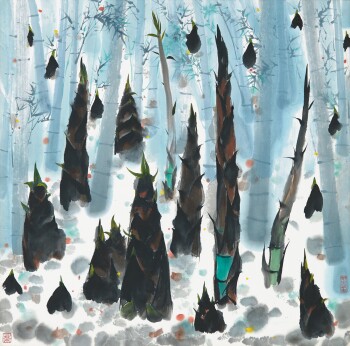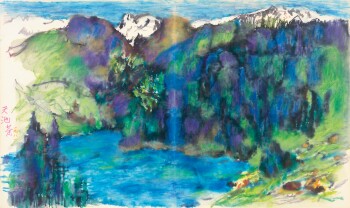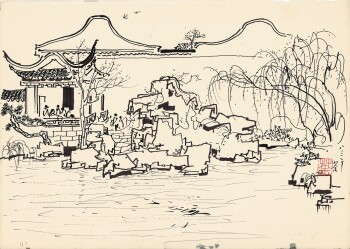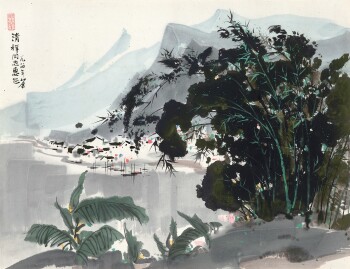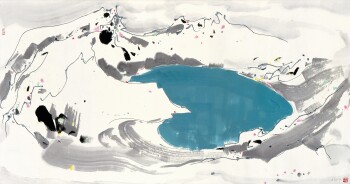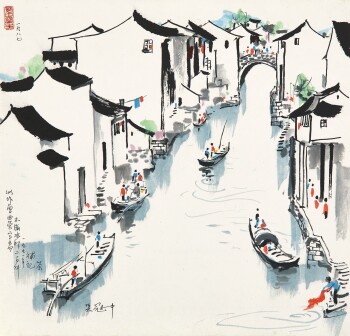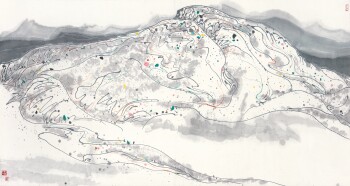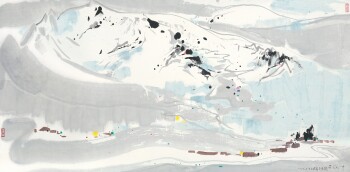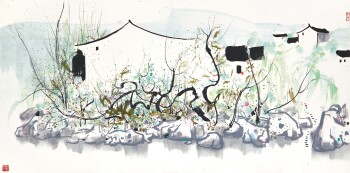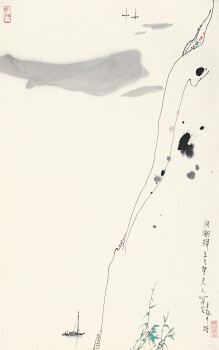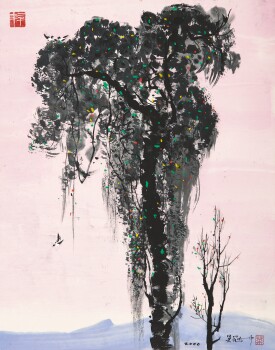W hen Wu Guanzhong painted from nature, he did not simply set his easel outside and record what his eyes observed. Instead, he perceived the myriad variations of his surroundings in order to create original compositions, just as he did in his ideal visions of the Heavenly Lakes. The artist traveled tirelessly through China’s mountains, forests, and rivers. After thoroughly reflection upon what he would call "illusions," he relied on his subjectivity – this relationship to nature – to formulate a composition, preserving or omitting various elements of the scenery in order to create a vivid and original tableau.
“Time changes space: snowy mountains, windstorms, tall trees, and wildflowers are moved by time, creating extraordinary scenes within the illusions I perceive.”
Vibrancy of Mountains depicts the vitality of early spring, with renewed growth on the cusp of bursting forth, rendered in dynamic lines and restless dots of color. This six-foot masterpiece exemplifies Wu Guanzhong’s celebrated abstract style in 1980s, with contours boldly outlined and light patches of ink wash applied erratically on the slope to create contrast between the snow-blanketed surface and crags emerging from under the melting ice. Lines of vermilion and emerald weave to and fro, dancing around splatters of color and across the icy layer, making their ascent to the summit. This is aesthetic formalism conveyed entirely by abstract means.

Later in late 1980s, the artist took a similar approach with A Mountain of Colors. The bouncing lines and powerful dots remain, conveying the vigor of the mountain in summertime. Yet without the light ink washes, the work expresses a distinctly different tone.
“Out in the snowland, except for dark shape, it is a mesmerizing sight of dazzling whiteness. With a closer look, however, the shades of white are not the same. They morph according to differences in altitude and depth of the terrain. It appears that xuan paper, known for its ability to convey artistic effects, works particularly well when illustrating the subtle gradation of snow."
Wu Guanzhong returned time and again to the theme of the snowy mountain. First appearing in his works was a depiction of Mount Daba in Sichuan in 1979, and later came portrayals of Mount Yulong in Yunnan and the Himalayan Mountains in the 1980s. Wu's experiments within the contrasts of black and white resulted in unique works, each exhibiting distinctive aesthetic beauty and ambiance of the landscapes.
Spring Snow offers a captivating wide-angle view of a snow-capped mountain ridge, featuring the mighty white dome in the center of the work. Rolling out gently along the valley, the icy slope is dotted by strikingly black ink at the tips of the peak, suggestive of vegetation peeking out from the snow. The dazzling white and heavenly blue, together with the silver-gray surrounding the peak, create an ethereal and tranquil atmosphere.
The Artist's Relationship with Ever-Changing Nature
"I hope that painters will continue to devote themselves to painting nature, and to respect the value of illusion in painting nature. Nature is the only place where one can experience such ever-changing illusions; faced with a photograph that is already fixed, one’s feelings have less space to explore."
Mountains are forms of monumental stillness, and yet Wu Guanzhong's paintings of snowy peaks manage to express distinct aspects, producing different experiences and emotional tones. Therein lies the difference between a fixed photograph and a painted scene, for Wu sought out and highlighted specific creative elements, letting the viewer experience the emotions that he poured into his painting.
As we have seen in the first part of the series on the artist,Wu Guanzhong's Reflections on the Heavenly Lakes – in the Artist's Own Words, each of his paintings reveals this changeable and subjective relationship between artist and nature – whether it is a depiction of melting snow on a mountain or the emergence of delicate bamboo shoots, signaling the coming of spring. Explore more of Wu Guanzhong's works at the upcoming Fine Chinese Paintings sale (10 July, Hong Kong).
- 1979
- 1981
- 1983
- 1984
- 1986
- 1987
- 1980s
- 1980s
- 1980s
- 1980s
- 2000
-
 1979
1979 -
 1981
1981 -
 1983
1983 -
 1984
1984 -
 1986
1986 -
 1987
1987 -
 1980s
1980s -
 1980s
1980s -
 1980s
1980s -
 Arnold Lee1980s
Arnold Lee1980s -
 2000
2000


